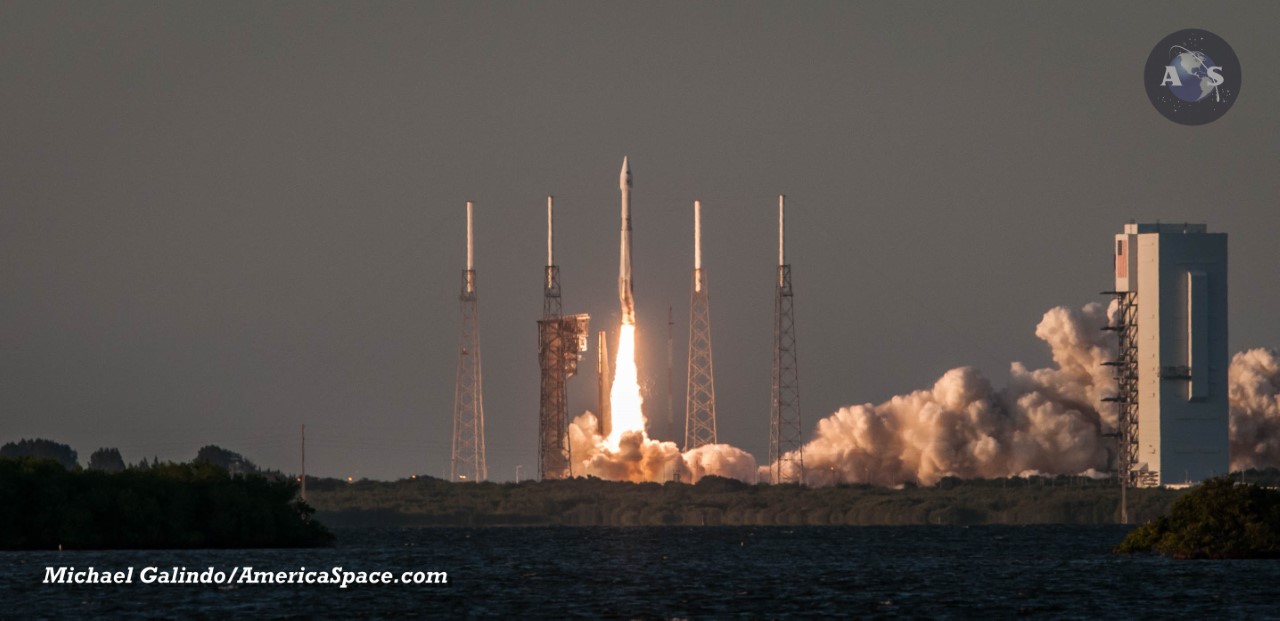
Just a half-hour before the Sun set over the Space Coast on Thursday, 8 September, United Launch Alliance (ULA) has successfully delivered NASA’s Origins, Spectral Interpretation, Resource Identification, Security, Regolith Explorer (OSIRIS-REx) spacecraft on its seven-year voyage to explore the near-Earth asteroid (101955) Bennu. Liftoff of the highly reliable Atlas V—flying in its rarely-used “411” configuration, equipped with a 14-foot-diameter (4-meter) Large Payload Fairing (LPF), a single strap-on, solid-fueled booster, and a single-engine Centaur upper stage—occurred at 7:05 p.m. EDT, precisely at the opening of the 115-minute “window.” OSIRIS-REx is now in the process of being delivered out of Earth’s gravitational clutches as it begins a two-year journey to reach Bennu.
“Congratulations to ULA, NASA and the entire integrated team who ensured the success of this launch,” said Col. Walt Jackim, 45th Space Wing vice commander and mission Launch Decision Authority. “We truly have a tremendous space team supporting this historic mission, the first since the Apollo program where we will bring a sample back from space. It’s my honor to be a part of this mission supporting the space industry. Assured access to space is a team sport and here on the Eastern Range, we continue to prove we are the ‘World’s Premier Gateway to Space.’”
“We are honoured to be chosen by NASA to launch this historic mission,” said Laura Maginnis, ULA vice president of Custom Services. “Thank you to our NASA customer and mission partners for the outstanding teamwork and attention to detail as we successfully started OSIRIS-REx on its seven-year journey to Bennu.” She added that ULA and its fleet of heritage vehicles—the Atlas V, Delta IV, and Delta II—had now successfully launched NASA missions to every planet in the Solar System. “We’re proud of our team,” she said, “for continuing our unprecedented track record of 100-percent mission success.”
As outlined in AmericaSpace’s OSIRIS-REx preview articles—available here and here—this ambitious $800-million mission is the third of NASA’s New Frontiers medium-class exploration program, following on the heels of the extraordinary success of New Horizons at Pluto and Juno at Jupiter. Initially entering solar orbit, OSIRIS-REx will flyby Earth in September 2017, to pick up a gravitational boost, before rendezvous with the near-Earth asteroid (101955) Bennu in August 2018. It will then spend 505 days mapping this virtually untouched “carbonaceous” remnant from the dawn of the Solar System’s 4.5-billion-year existence, before selecting a location to descend and take a sample.
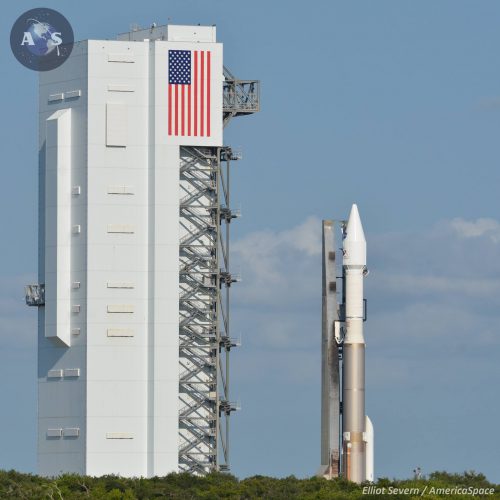
Using its ingenious Touch-and-Go Sample Acquisition Mechanism (TAGSAM), the spacecraft will draw a specimen of between 2 ounces (60 grams) and 4.4 pounds (2 kg) from Bennu’s surface at some point in July 2020. These priceless extraterrestrial grains and the collector head will then be secured inside a Sample Return Canister (SRC), and OSIRIS-REx will depart the asteroid in March 2021, returning to Earth on 24 September 2023. The SRC will separate from the spacecraft and—protected by an ablative heat shield and aeroshell—will plunge into our atmosphere, headed for a parachute-guided touchdown in the Utah Training and Test Range (UTTR) in Tooele County, Utah.
Five years to the month after it was selected, OSIRIS-REx was delivered from prime contractor Lockheed Martin’s Littleton, Colo., facility to the Kennedy Space Center (KSC) in Florida on 20 May 2016 and headed directly into final processing. Inside the Payload Hazardous Servicing Facility (PHSF), the spacecraft underwent weight and center-of-gravity tests, its solar arrays were cleaned and partially deployed, and it was fueled with hydrazine. Late last month, OSIRIS-REx was encapsulated inside its 14-foot-diameter (4-meter) Large Payload Fairing (LPF) and on 29 August was transferred from the PHSF to the Vertical Integration Facility (VIF) at SLC-41. When fully stacked, the Atlas V 411—which comprises a Common Core Booster (CCB), a Centaur upper stage, and a single, strap-on solid-fueled booster—stood an impressive 189 feet (57.6 meters) tall.
As September dawned, the complete vehicle passed smoothly through an Integrated Systems Test and Flight Readiness Review (FRR), followed by the standard Launch Readiness Review (LRR) on Tuesday. Yesterday (Wednesday), the Atlas V 411 rolled a quarter-mile (400 meters) from the VIF to the SLC-41 pad surface. Once there, it was carefully centered and propellant umbilicals and data connections were established. The track mobiles from the Mobile Launch Platform (MLP) were removed, and ULA engineers moved into preparations for formal countdown operations, targeting an opening launch attempt on Thursday evening.
OSIRIS-REx had a broad swath of dates, extending through 12 October, in which to launch, with Thursday, Friday, and Saturday evening all reserved on the Eastern Range to get the mission underway. In its L-1 Weather Briefing on Wednesday morning, the 45th Space Wing at Patrick Air Force Base noted an 80-percent likelihood of acceptable conditions for Thursday’s launch attempt, deteriorating slightly to 70-percent favorable in the event of a delay to Friday or Saturday. “A tropical wave in the Central Caribbean approaches the Yucatan Peninsula on launch day,” it was explained. “On launch day, the pattern remains similar with on-shore winds; however, moisture recovers during the day. The sea breeze will develop late morning and migrate inland early afternoon, with isolated showers along the boundary.” In summary, the 45th highlighted a “low thunderstorm threat” and a similarly low threat of solar proton flux exceeding Launch Commit Criteria (LCC). The key violating factor for all three launch attempts was an infringement of the Cumulus Cloud Rule.
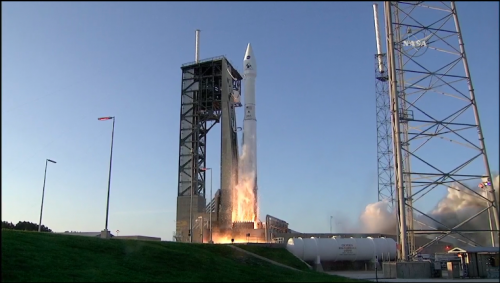
Aboard the CCB, storable rocket-grade kerosene (known as “RP-1”) had previously been loaded, with liquid oxygen tanking occurring late in the countdown, allowing boiled-off cryogens to be replenished until close to T-0. In readiness for the fueling regime, the propellant storage area was chilled down, in order to prevent thermal shocking and potential damage to critical vehicle components. At 2:50 p.m. EDT the fuel lines were purged with inert gaseous nitrogen, and a couple hours later SLC-41 was cleared of all personnel and roadblocks were established. Flight Control and Communications preparations concluded at about this time and at 5:05 p.m. the Launch Director polled the ULA team and a “Go” was issued to begin loading cryogens. By this stage, the weather forecast had reportedly improved to 90-percent favorable.
Today’s mission was dedicated to Dr. Michael J. Drake, former director of the Lunar and Planetary Laboratory at the University of Arizona. Dr. Drake was OSIRIS-REx’s original principal investigator, but died of liver cancer in September 2011, just months after the mission received the go-ahead as the third member of New Frontiers. He was replaced in the role by his deputy principal investigator, Dr. Dante Lauretta. Touchingly, emblazoned on the exterior of the Atlas V 411 were the words “Colleague, Friend and Visionary” to honor Dr. Drake, as well as a mention for ULA’s Larry Richardson, who died last December.
By 6 p.m. EDT, with around an hour remaining until the opening of Thursday’s launch window, liquid oxygen tanking aboard the Centaur upper stage had attained Flight Level and entered Replenishment Mode. At the same time, loading of liquid hydrogen aboard the Centaur got underway, as the loading of the CCB continued toward completion. During this period, at 6:35 p.m., Clay Flinn of the 45th Weather Squadron presented a final weather briefing. Mr. Flinn noted a 90-percent chance of acceptable weather and weather readiness was declared as “Go.” Watching the launch was AmericaSpace’s Michael Galindo. “Mostly clear skies, breezy and cool,” was his perspective in the final stage of the countdown. “Perfect weather for a launch.”
OSIRIS-REx transitioned to internal power at 6:55 p.m. A final “Go/No-Go” poll of all stations, led by the ULA Launch Conductor, was met with a string of “Go” calls across the board. The final station, the Launch Director, then issued authorization for the Launch Conductor to launch at the opening of the window at 7:05 p.m., about a half-hour before sunset. This allowed teams to press ahead into the Terminal Countdown and at 7:01 p.m. EDT the clock was released from its final pre-planned hold at T-4 minutes. During the Terminal Countdown, the Atlas V’s propellant tanks were pressurized and the Flight Termination System (FTS)—tasked with destroying the vehicle in the event of a major contingency during ascent—was placed onto internal power and armed. “Range Green,” came the call at T-1 minute.
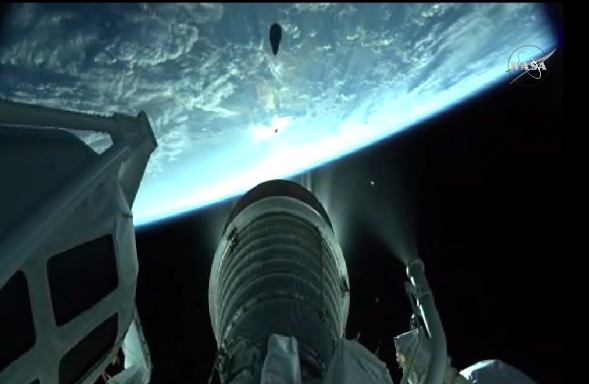
At T-2.7 seconds, the Russian-built RD-180 main engine at the base of the CCB roared to life, generating 860,000 pounds (390,000 kg) of thrust from its twin nozzles. Today’s flight was the 65th launch of an Atlas V and the mission departed SLC-41 at T+1.1 seconds, rising vertically for its first few seconds. However, the unusual configuration of the 411 variant—equipped with the single, side-mounted solid-fueled booster—created a peculiarly asymmetric perspective for the gathered spectators on the Space Coast. Although the RD-180 engine has a steering gimbal which compensates for the offset booster’s thrust, the first-stage plume appeared to flare noticeably to one side.
Seven seconds after liftoff, the avionics aboard the Centaur commanded a pitch, roll, and yaw program maneuver to establish the rocket onto a flight azimuth of 89.0 degrees. The strap-on booster was jettisoned at T+139 seconds, whilst the RD-180 continued to burn for almost two more minutes. At 7:09 p.m., a little over four minutes after departing the Cape, the RD-180 fell silent, with Booster Engine Cutoff (BECO), setting the stage for the next phase of OSIRIS-REx’s journey. In rapid succession, the Centaur/OSIRIS-REx stack separated from the CCB and at four minutes and 19 seconds into the ascent the first of two “burns” got underway. Burning with 22,330 pounds (10,128 kg) of thrust, the Centaur’s restartable RL-10-4-2 engine ran for eight minutes and four seconds, during which time the LPF was jettisoned. Shutdown of the Centaur occurred at 7:17 p.m.
By this point, the stack had reached an altitude of about 116 nautical miles (215 km), moving in excess of 16,000 mph (25,700 km/h). The stack then coasted for around 21 minutes, ahead of the second Centaur burn—nicknamed the “trans-Bennu burn”—which got underway at 7:38 p.m. By this stage, the vehicle had reached an altitude of 156 nautical miles (289 km) and was heading out across Africa at 17,550 mph (28,240 km/h). This was a shorter burn, lasting approximately six minutes and 50 seconds, with engine cutoff at 7:45 p.m. By this stage, stack was in an orbit with a perigee of 112.6 nautical miles (208.5 km) and an apogee of 3,443.9 nautical miles (6,378.1 km). And 15 minutes after that—traveling far in excess of 22,000 mph (35,400 km/h)—OSIRIS-REx itself was deployed from the Centaur to begin its voyage to Bennu and back.
Want to keep up-to-date with all things space? Be sure to “Like” AmericaSpace on Facebook and follow us on Twitter: @AmericaSpace
Missions » OSIRIS-REx »



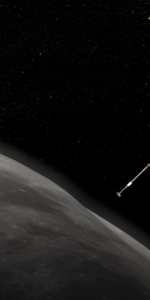
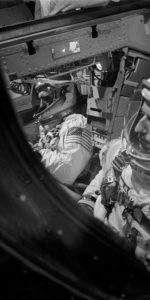
It did not blow up!
Good thing it was not a falcon.
falcons are a new rocket system and are proving a good platform they learn as they grow even from mistakes musk does a good job with his new space company and this latest launch of an atlas (russian booster engine) did the job and american high tech spacecraft make all america look good we never lost it we just slowed down i cant wait to see what happens and what this sample will prove for us
“falcons are a new rocket system and are proving a good platform”
Not that new and not that good. Who are you trying to fool? Yourself?
Falcon 9 has a better launch record than the Ariane 5 did at the same point in its launch history.
Jester Gambolt –
Did the Falcon 9 explosion also put the OSIRIS-REx mission in serious “jeopardy”
“The SpaceX rep informed me that while the deluge wasn’t functioning optimally it was still helping to suppress the fire somewhat. That was fine except for one thing — our 1.2 million gallon tank was being depleted at a rapid rate and there was no way to refill the tanks fast enough to sustain the output. If the tanks ran dry then the motors to the pumps would burn up, which would render the deluge system inoperable for other launch pads meaning our upcoming ULA launch might then be in danger.”
And, “If OSIRIS-REx was in such jeopardy, it runs in stark contrast to the reports that followed in the days of the incident, which seemed to imply — by omission — a much rosier state of affairs at the ULA launch site during the conflagration occurring at nearby SLC-40 than what the 45th Space Wing’s release suggests. While it’s not apparent if the cooling system’s failure was related to the SpaceX mishap, or merely coincidental, it is clear that the IMT’s actions helped save the spacecraft.”
From: ‘Gripping details emerge of 45th Space Wing’s response to SpaceX explosion’ By Curt Godwin September 13th, 2016
At: http://www.spaceflightinsider.com/organizations/space-exploration-technologies/gripping-details-emerge-45th-space-wings-response-spacex-explosion/
“‘No sooner had we accomplished the securing of the pumps when I was approached by another one of our range users who explained they were losing pressure on the chillers at a neighboring launch complex,’ Lindsey wrote, referring to an air conditioning system for the OSIRIS-REx spacecraft. ‘Without those chillers the spacecraft for the next launch would be lost.'”
From: ‘Quick work saved the OSIRIS-REx asteroid mission from nearby explosion’
By Stephen Clark September 13, 2016
At: http://spaceflightnow.com/2016/09/13/quick-work-saved-the-osiris-rex-asteroid-mission-from-nearby-explosion/
“‘If you talk about launch vehicles, we believe our responsibility to the nation is to take care of things that normal people cannot do, or don’t want to do, like large launch vehicles,’ Bolden said. ‘I’m not a big fan of commercial investment in large launch vehicles just yet.'”
From: ‘Falcon Heavy? New Glenn? NASA chief says he’s not a ‘big fan’ The NASA administrator seems to have little faith in Jeff Bezos and Elon Musk’ By Eric Berger 9/14/2016
At: http://arstechnica.com/science/2016/09/nasa-chief-says-hes-not-a-big-fan-of-private-investment-in-large-rockets/
NASA’s critical ability to do timely launches of important national human and robotic missions should not be put at risk by the private expectations of a billionaire, or a small group of billionaires, whose goals may have inherent risks and other issues that have not been thoroughly, scientifically, and publicly analyzed due to the President’s direct and indirect partisan political influence on NASA’s leadership.
NASA Administrator Charles Bolden’s comment about “commercial investment in large launch vehicles” may imply large and diverse launch vehicle and launch site risks to the public’s, and our nation’s, interests that require extremely careful scientific and engineering scrutiny and publicly understood and accepted flight rules and operational launch risk minimization methods.
Secretive and zig-zagging highly partisan political space ‘deals’ made in backrooms are not the solution to increasing and optimizing the public’s support for NASA and our space industry, nor will such ‘deals’ help to grow our American human and robotic space exploration program and allow NASA to provide the sustainable international leadership needed to reduce the risks and costs of LEO and beyond LEO missions.
If NASA’s leadership is to properly execute our current space law and take full “responsibility to the nation” it will need to exemplify far more public transparency to maintain bipartisan Congressional support for the setting of scientifically, technologically, and financially doable short and long term national space goals and in developing the needed consistency for building and maintaining the industrial, technological, and risk minimization assets and sophistication needed to successfully implement such goals.
An independent, open, and rigorous investigation and assessment is needed to assure that NASA implements all feasible launcher risk minimization options to avoid launch vehicle failure, such as that of SpaceX’s Falcon launcher or any proposed new and larger launcher, or some other critical incident that could negatively impact our nation’s capability to launch important national missions at the Cape Canaveral Air Force Station and the nearby Kennedy Space Center.